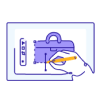SAP FPM Training || SAP FPM certification Training || SAP FPM Online training || SAP FPM self-paced training || SAP FPM Instructor-Led training
Key Features of Training:
- 30 Hrs Instructor-led Training
- Mock Interview Session
- Project Work & Exercises
- Flexible Schedule
- 24 x 7 Lifetime Support & Access
- Certification and Job Assistance
SAP FPM(Floorplan Manager):
SAP Floorplan Manager (FPM) is a user interface (UI) framework and development tool provided by SAP for creating consistent and efficient user interfaces for SAP applications. FPM simplifies the development of web-based applications within the SAP ecosystem by offering a set of reusable UI components and design patterns. With FPM, developers can build interactive and responsive applications, known as "floorplans," which are tailored to specific business processes. These floorplans provide a consistent look and feel, improving user experience and reducing development effort. FPM supports various UI technologies, such as Web Dynpro ABAP and Web Dynpro Java, making it versatile and adaptable to different SAP landscapes.
Prerequisites: Who can attend SAP FPM Training?
- Basic SAP Knowledge
- Programming Skills
- Web Development Skills
- SAP User Interface (UI) Knowledge
- Access to SAP Environment
- Good Communication Skills
Responsibilities of SAP FPM Consultant:
- Requirement Analysis
- Solution Design
- Development
- Testing.
- Documentation
- Training and Support
Course Benefits
- Job opportunities
- Promotion opportunities (Salary Hike)
- Increased productivity
- Improved decision-making
- Gain in-demand skills
What is the future of SAP FPM Consultant?
- Shift to SAP Fiori and SAPUI5
- Integration with SAP S/4HANA
- Low-Code/No-Code Platforms
- Industry-Specific Expertise
- Data Analytics and AI Integration
The fee for SAP FPM(Floorplan Manager) training can vary depending on several factors such as the location, duration of the course, training format, and level of expertise. SAP offers various training options for FPM, including instructor-led courses, e-learning courses, and virtual live classrooms.
For More details you can Register Sign Up
SAP FPM(Floorplan Manager) Certification FAQ's:
1. What is SAP FPM (Floorplan Manager)?
A: SAP Floorplan Manager (FPM) is a framework provided by SAP for developing web-based applications with a consistent user interface. It is often used to create custom applications within the SAP NetWeaver Business Client (NWBC) environment.
2. Why use SAP FPM?
A: SAP FPM simplifies the development of user interfaces for SAP applications by providing pre-built UI components and a framework for building custom UIs. It helps maintain consistency in the user experience across different SAP applications.
3. Is there a certification for SAP FPM?
A: As mentioned earlier, there may not be a specific certification for SAP FPM. However, SAP offers certifications related to various SAP technologies and modules. Check the SAP Education website for the latest certification offerings.
4. How can I prepare for a certification related to SAP FPM?
A: If you're interested in certifications related to SAP technologies, you should start by reviewing the official certification materials provided by SAP. This often includes study guides, sample questions, and training courses. Additionally, hands-on experience with SAP FPM projects can be invaluable.
5. Are there any prerequisites for SAP FPM certification exams?
A: Prerequisites can vary depending on the specific certification exam. SAP certifications typically require a combination of relevant training, practical experience, and a solid understanding of the subject matter. Check the official SAP certification page for specific requirements.
6. Are there study materials or training courses available for SAP FPM?
A: SAP Education offers training courses for various SAP technologies, and you can find relevant courses for SAP FPM. Additionally, you can find study materials, books, and online resources to help you prepare for the certification.
7. How do I register for an SAP certification exam?
A: To register for an SAP certification exam, you typically need to create an account on the SAP Training and Certification Shop website. From there, you can browse available exams, select the one you want, and follow the registration process.
8. What is the format of SAP certification exams?
A: SAP certification exams typically consist of multiple-choice questions and may include scenario-based questions. The format and duration of the exams can vary, so it's essential to review the specific details for the exam you plan to take.
9. Is SAP FPM still relevant in 2023?
A: The relevance of SAP FPM depends on the specific needs of organizations and their existing SAP landscapes. While newer technologies and user interface frameworks have emerged, SAP FPM may still be used in legacy systems or in situations where maintaining consistency with existing SAP applications is critical.
10. What are the key components of SAP FPM?
A: SAP FPM consists of several key components, including the Floorplan Manager framework, which provides a set of tools and templates for building web-based UIs. It also includes UI Building Blocks (UIBBs), which are reusable UI elements that can be configured and assembled to create application screens.
SAP FPM(Floorplan Manager) Certification:
- Visit the SAP Training and Certification Website: The official SAP Training and Certification website is the primary source for information on available certifications, exam details, prerequisites, and study materials. You can access this website to browse through the latest certification offerings.
- Search for Relevant Certifications: Use the website's search or navigation features to find certifications related to your area of interest. This may include UI development, SAP Web Dynpro ABAP, or other relevant categories that touch upon SAP FPM.
- Review Certification Requirements: For each certification, review the prerequisites and requirements to ensure you meet the criteria for eligibility.
- Access Study Materials: SAP often provides study guides, sample questions, and recommended training courses to help candidates prepare for certification exams. These resources are valuable for exam preparation.
- Register for Exams: Once you've chosen a certification path and prepared adequately, you can register for the certification exam through the SAP Training and Certification website.
- Prepare and Take the Exam: Study diligently, review the relevant materials, and then take the certification exam at an authorized SAP exam center.
- Stay Informed: Keep an eye on updates from SAP Education for any new certifications or changes to existing ones. Join SAP communities and forums to connect with other professionals who can share their experiences with certification exams.
SAP FPM(Floorplan Manager) Curriculum:
Module 1: Introduction to FPM
- What is Floor Plan Manager?
- Benefits of Floor Plan Manager
Module 2: Floor plans and its types
- Object Instance Floorplan (OIF)
- Quick Activity Floorplan (QAF)
- Overview Floorplan (OVP)
- Guided Activity Floorplan (GAF)
- Architecture of FPM based Web Dynpro Applications
- Overview of Component Interface IF_FPM_UI_BUILDING_BLOCK
Module 3: How to create a FPM application
- Understanding common steps in configuring FPM application
- Creating Application configuration
- Creating Component configuration
- Configuration of UIBBs
- Developing an OIF application
- Developing a GAF application
- Developing a OVP application
- Configuring Identification Region (IDR) component
- Creating and Configuring an FPM Dialog box
Module 4: FPM Configuration Editor
- Exploring Configuration editor
Module 5: Launching Configuration editor
- Configuration editor for OIF
- Configuration editor for OIF
- Configuration editor for OVP
- Overview of Initial Screen and Confirmation Screen
- Configuring Initial Screen
- Configuring Confirmation Screen
Module 6: FPM Toolbar
- Toolbar for Initial Screen
- Toolbar for OIF
- Toolbar for GAF
Module 7: Application specific Configuration Controller
- Declaring the AppCC in FPM Configuration Editor
- AppCC Functions – OIF Application
- AppCC Functions – GAF Application
- AppCC Functions – OVP Application
- Switching variants
- Invoking Sub-roadmaps
- Accessing application parameters
Module 8: Creating Quick Help
- Creating Quick Help – Direct method
- Creating Quick Help – Via documentation object
Module 9: Working with Toolbar
- Working with Toolbar, Creating a button (OIF)
- Methods in Interface IF_FPM_CNR_OIF
- Methods in Interface IF_FPM_CNR_GAF
Module 10: Identification Region (IDR)
- Adjusting the Identification Region (IDR)
- Adjusting the Identification Region (Header Area )
- Adjusting the Identification Region ( Ticket Area )
- Adjusting the Identification Region (Item Area )
Module 11: FPM Error Page
- Calling an FPM Error Page
Module 12: Shared Data Component
- What is Shared Data Component?
- Implementation
Module 13: GUIBB – Generic User Interface Building Block
- What is GUIBB?
- Feeder Class
- Types of GUIBBs
Module 14: Interface Methods
- IF_FPM_GUIBB
- IF_FPM_GUIBB_*
- IF_FPM_GUIBB_*_EXT
- Form GUIBB
- List GUIBB
- Tabbed GUIBB
- Search GUIBB
Module 15: Navigation in FPM Applications
- Using Launchpad
- FPM Navigation APIs
SAP FPM(Floorplan Manager) Interview Questions and Answers:
1. What is SAP FPM, and why is it used?
SAP FPM (Floorplan Manager) is a framework for developing web-based user interfaces in SAP applications. It's used to create consistent and user-friendly UIs for SAP processes.
2. Explain the key components of SAP FPM.
The key components of SAP FPM include Floorplans, UIBBs (User Interface Building Blocks), OIF (Object Instance Floorplan), and FPM Eventing.
3. What is the role of a Floorplan in SAP FPM?
A Floorplan defines the overall layout and structure of the user interface. It determines the arrangement of UIBBs on the screen.
4. What are UIBBs, and how are they used in SAP FPM?
UIBBs (User Interface Building Blocks) are reusable UI elements that can be embedded in different Floorplans to display data or capture user input.
5. What is OIF (Object Instance Floorplan) in SAP FPM?
OIF is a Floorplan type that is used for displaying and managing data related to a specific object instance, such as a customer or a sales order.
6. Explain FPM Eventing in SAP FPM.
FPM Eventing allows communication between different UIBBs in an FPM application. It enables one UIBB to trigger actions or pass data to another UIBB.
7. What are the different types of Floorplans in SAP FPM?
Commonly used Floorplan types include OIF (Object Instance Floorplan), GAF (Generic Application Floorplan), and QAF (Quick Activity Floorplan).
8. How is configuration done in SAP FPM?
SAP FPM configuration is typically done using the Web Dynpro Component Configuration (WDCC) tool, where you define the structure and behavior of the UI.
9. What is an FPM Event Handler?
An FPM Event Handler is a method that is executed in response to a specific event triggered by a UIBB. It defines how the application should react to the event.
10. Explain the concept of Context Mapping in SAP FPM.
Context Mapping is the process of connecting UI elements (fields, buttons, etc.) in the UIBB with the data in the application context.
11. What is the purpose of FPM Enhancement Points?
FPM Enhancement Points allow developers to customize standard FPM applications by adding or modifying functionality at predefined points in the framework.
12. How can you handle errors and validations in SAP FPM?
You can implement error handling and validations by using FPM error messages, BADI implementations, or custom code within FPM Event Handlers.
13. What is the role of an FPM Application Configuration?
FPM Application Configuration defines the overall structure of an FPM application, including Floorplans, UIBBs, and their configurations.
14. Explain the difference between static and dynamic configurations in FPM.
Static configuration is done at design time and remains unchanged during runtime. Dynamic configuration allows changes to the UI structure during runtime based on user actions or conditions.
15. What is the purpose of the FPM UIBB Configuration tool?
The FPM UIBB Configuration tool is used to define the properties and behavior of UIBBs, such as data binding and event handling.
16. How can you pass data between UIBBs in SAP FPM?
Data can be passed between UIBBs using FPM Eventing or by storing data in the application context and accessing it from different UIBBs.
17. What is an FPM Application Exit and when would you use it?
An FPM Application Exit is a mechanism to implement custom logic in an FPM application. It is used when standard configuration and enhancements are not sufficient.
18. Explain the concept of BOPF integration in SAP FPM.
BOPF (Business Object Processing Framework) integration allows FPM applications to interact with and manage SAP Business Objects.
19. What is the role of the Configuration Editor in SAP FPM?
The Configuration Editor is a tool used to create and edit FPM configurations, including Floorplans, UIBBs, and event handlers.
20. What is FPM UIBB Personalization, and how is it implemented?
FPM UIBB Personalization allows users to customize the appearance and layout of UIBBs. It can be implemented by enabling personalization options in the configuration.
21. How do you handle security and authorization in SAP FPM applications?
Security and authorization in FPM applications are typically managed through SAP's standard authorization mechanisms, which can be integrated into the application's logic.
22. What is the role of the Event Loop in SAP FPM?
The Event Loop manages the sequence of events and event handlers in an FPM application, ensuring proper execution and data flow.
23. Explain the concept of BADI (Business Add-In) integration in SAP FPM.
BADI integration allows developers to enhance FPM applications by implementing custom logic through predefined BADI interfaces.
24. How can you optimize the performance of an SAP FPM application?
Performance optimization can be achieved by minimizing data retrieval, reducing unnecessary event processing, and implementing efficient coding practices.
25. What is the difference between FPM Application Configuration and Component Configuration?
FPM Application Configuration defines the overall structure of an FPM application, while Component Configuration defines the behavior of individual UI components within the application.
26. What are the advantages of using SAP FPM for UI development?
Advantages include reusability of UI components, consistent user interfaces, reduced development effort, and streamlined maintenance.
27. Explain the concept of an FPM UIBB Adapter.
An FPM UIBB Adapter is used to encapsulate reusable logic and UI elements for a UIBB. It promotes modular and maintainable code.
28. How can you customize the look and feel of an FPM application?
You can customize the application's appearance by using CSS, themes, and the SAP UI Theme Designer.
29. What is the purpose of FPM Configuration Profiles?
Configuration Profiles allow you to manage different sets of FPM configurations for the same application to meet different business requirements.
30. Can SAP FPM be integrated with SAP Fiori?
Yes, SAP FPM can be integrated with SAP Fiori by using Fiori elements or custom development to create modern and responsive user interfaces.
Participants will have 24/7 access to our online lab, providing hands-on experience with SAP FPM tools and scenarios.
This includes server access to S/4 HANA 2023 for 1 year, ensuring you have ample time to practice and apply your skills in a real-world environment.
With this extended access, you can work on projects, explore advanced features, and solidify your understanding of SAP FPM in the latest SAP S/4 HANA version.














